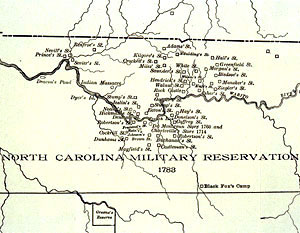
Frontier Stations
On the Tennessee frontier before 1796 the terms “station” and “fort” were used interchangeably to mean a structure, or adjacent structures, that could temporarily house more than one family and provide protection from Native American attacks. The traditional meaning of “fort” might have been more appropriate if the frontiersmen had used the word to mean a work or works designed, constructed, and garrisoned by military personnel. Such was not the case, however.
A station or fort could be a single strong house in a central location in which persons from neighboring houses gathered for security. The terms were applied, also, to houses enclosed or connected by stockading that surrounded an interior open space. At times “fort” was used to emphasize that additional security was provided by stockading, blockhouses, and related, but improvised, defensive works. At other times, the term referred to a frontier house with no special fortification, but at which as few as two or three militiamen were on duty to help defend it from attackers. Probably the most appropriate use of the word “fort” was to dignify the modest military installations of the early period: Fort Grainger at the mouth of the Little Tennessee River, Fort Blount at the crossing of the Cumberland near Gainesboro, the blockhouse at Southwest Point near Kingston, and the post at Tellico Blockhouse. Once established, stations became landmarks along the frontier trails and roads. As identifiable overnight stops, they provided food and sleeping space to passing travelers.
Early stations, or forts, usually took the name of the owner-occupant of the principal or central house. Stations housed as many as 30 or 40 people, but on April 11, 1793, when settlers believed Indian attacks were imminent, 280 men, women, and children gathered in small huts at John Craig’s station on Nine Mile Creek in an area that later became Blount County. Wherever large numbers crowded a station, living conditions soon became unbearable. In addition to providing shelter for people, stockaded stations sometimes enclosed open space large enough for the temporary accommodation of horses and cattle. Both Kasper Mansker’s and Isaac Bledsoe’s were examples of such capacity. Fortunately for the settlers, attacks were usually short-lived, and often the rush to gather for protection was the result of a false alarm.
The original Cumberland settlers planned eight stations in advance of their arrival, but probably only four had been constructed by 1780. The remaining four were completed within the next few years, although one of them, Asher’s, was never permanently occupied. In the case of the Cumberland Association of 1780-83, stations served as precincts or sub-seats of government where voters elected representatives to the ruling council of government, the court of triers. Not all stations were the result of such coordinated and advanced planning, though. In fact, stations usually developed quite informally as settlers acquired contiguous land and designated one location as a place of refuge and security. In this sense, a station served as the center of the settlement community and could develop further. James White sowed the seeds for what would become the city of Knoxville, for instance, when he laid out sixty-four town lots on land adjacent to White’s Fort in 1792.
From 1780 to 1795 the fort at Nashborough and Kilgore’s, Mansker’s and Isaac Bledsoe’s stations figured prominently in the defense of the Cumberland region. Similar installations at Fort Watauga and Fort Patrick Henry on the Long Island of the Holston had stood effectively against sizable assaults in the Watauga country from 1772 through 1776. Built in 1785, James Houston’s fort on Little Nine Mile Creek in Blount County was a bastion for local defenses until the end of the Indian wars. But not all stations and forts were defensible strongholds. Zeigler’s station, built in Sumner County circa 1790, was a huddle of three or four family cabins with no stockading. In a 1791 attack four defenders were killed and one burned to death, four were wounded but escaped, three escaped unhurt, and thirteen women and children were taken prisoner.



